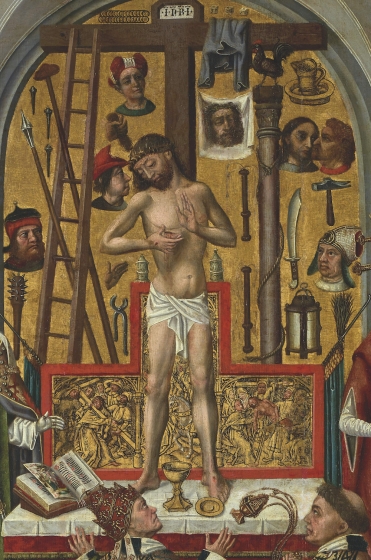This archived website 'Flemish primitives' is temporarily not being updated. Certain functionality (e.g. specific searches in the collection) may no longer be available. News updates about the Flemish primitives will appear on vlaamsekunstcollectie.be. Questions about this website? Please contact us at info@vlaamsekunstcollectie.be.
Groeninge Museum acquires Mass of Saint Gregory

The Groeninge Museum recently acquired a late-medieval panel depicting the Mass of Saint Gregory. The intriguing subject became highly popular in Northern Renaissance painting during the 15th and early 16th century when the transubstantiation - the bread and wine offered at the sacrament of the Eucharist during mass changes into both the flesh and blood of Jesus Christ - became an increasingly controversial dogma at the Councils of the Church and the nascent Reformation movement.
As recorded in the 13th century Legenda Aurea, Gregorius the Great doubted that Christ himself became a corporal presence during the Eucharistic offering until Christ appeared on the altar, showing his stigmata while the Pope was celebrating mass.
During the Middle Ages, the subject was represented in different media, including wall-, panel-, and miniature. In these depictions, the appearance of Christ was often depicted as Man of Sorrows, spilling his blood.
Among the earliest known depictions from the Low Countries is a Mass of Saint Gregory, now lost, that was attributed to the Master of Flémalle (aka Robert Campin) from Tournai. A copy survives in the Royal Museums of Fine Arts of Belgium in Brussels.
Looking at several Netherlandish prototypes, as source for inspiration, the German engraver Israhel van Meckenem (1440/1445 - 1503) made a print depicting The Mass of Saint Gregory that became highly influential. The composition places the altar in a gothic church-interior and surrounds the figure of Christ with the tools of his Passion, the Arma Christi.
Whereas the Arma are also prominently displayed in the background of the panel, the figure of Christ stands on the altar in front of an altarpiece, in contrast to the print where the Man of Sorrows rises from a sarcophagus placed on the mensa of an altar.
The fact that the painting represents an altarpiece makes the new acquisition particularly intriguing as it can help to convey to the public how some panels in the Groeninge Museum were displayed in churches during the late Middle Ages. But we are not entirely sure if the altarpiece is a panel painting; the painter may also show a retable of polychromed sculpture or even one made from embroidery.
The panel was formerly part of the collection of the Marqués de Conquistas in Madrid and has usually been considered to be the work of a Hispano-Flemish painter. The quality of execution, the handling of light and the particular care used to represent the costly gowns of the figures are remarkable.
Several painted versions are known of the composition, and all seem to have been produced by Brussels' workshops around 1500, as Didier Martens has demonstrated a few years ago. A version, now kept at the Musée Cluny in Paris is particularly close to the version that has now been brought to Bruges. Technical studies that will be carried out in the next few months by the Flemish Research Centre for the Arts in the Burgundian Netherlands will - no doubt - help to shed light on the production process of the painting. In the meantime, the Bruges' museums are proud to have secured another Flemish Primitive to their collection.
(News item January 20, 2017)







